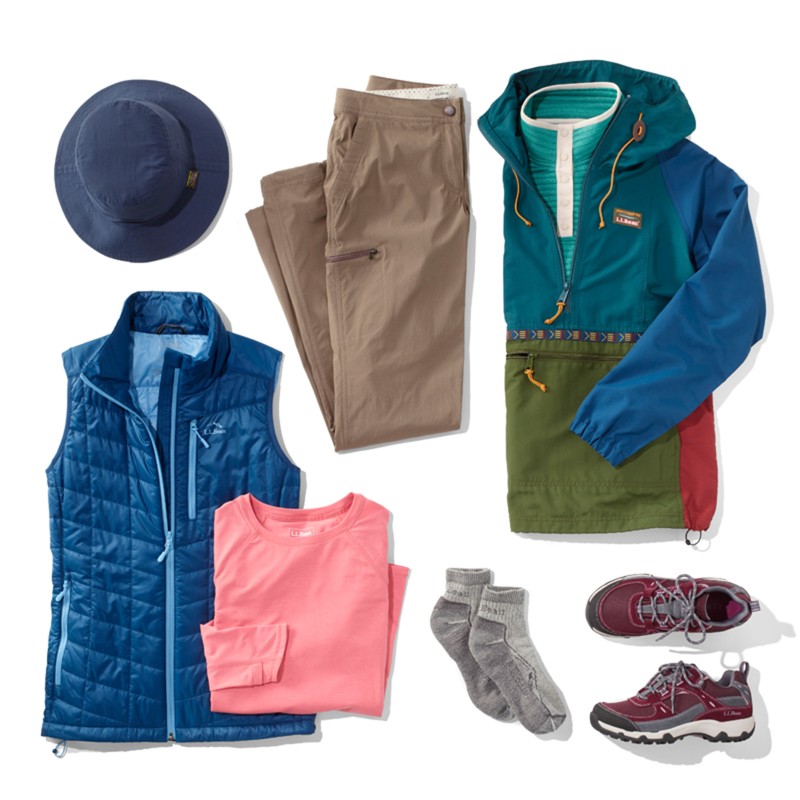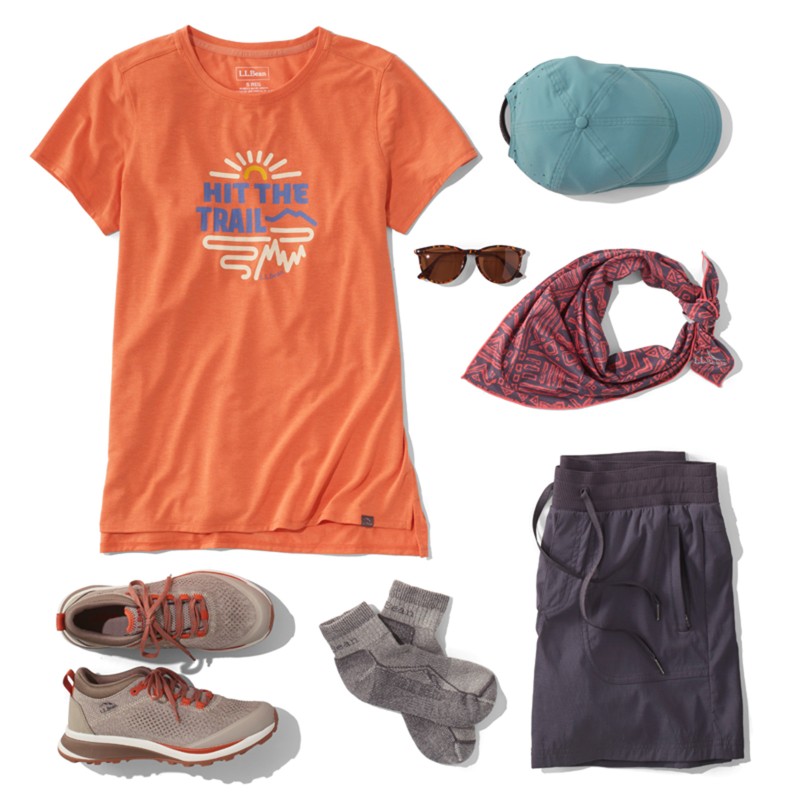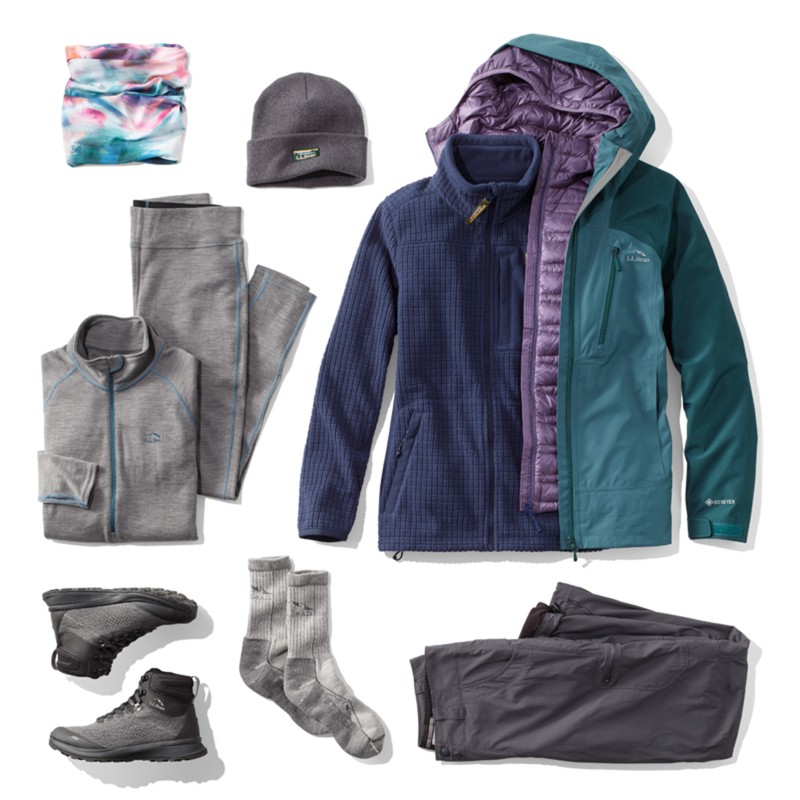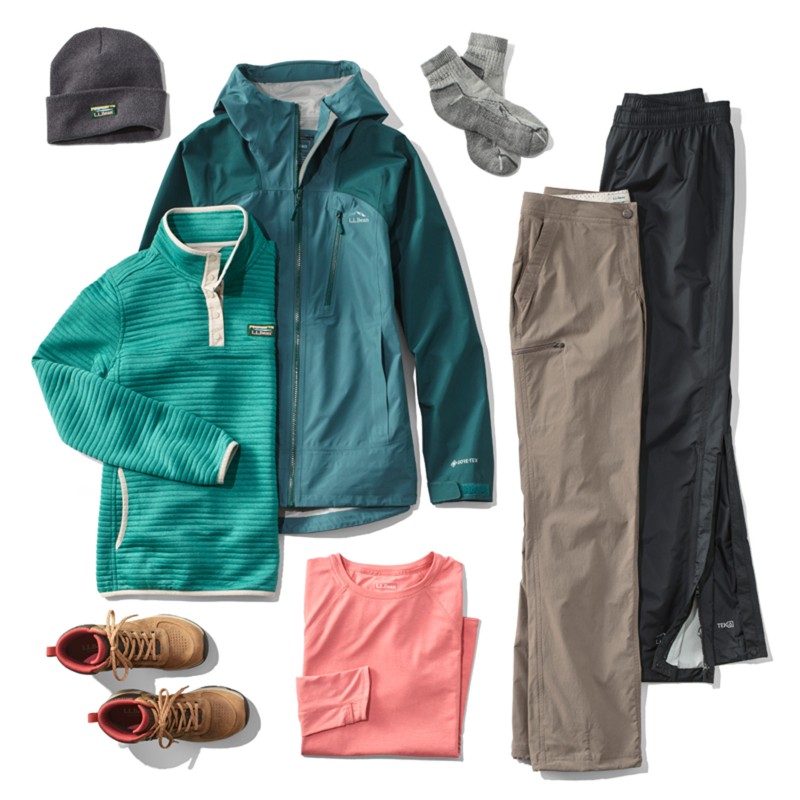(DESCRIPTION)
[00:00:00.00] A woman stands in front of racks filled with clothing and shoes. Hannah, Comfy Hiking Enthusiast.
(SPEECH)
[00:00:00.33] Hey. I'm Hannah. I love hiking and I love being comfortable. And most of all, I love doing both together.
(DESCRIPTION)
[00:00:06.33] A group of people hike up the side of a rocky mountain.
(SPEECH)
[00:00:06.48] The perfect hiking clothing changes depending on when and where you're hiking. So I'm going to help you figure out what to wear to feel grayed out there. Here's our guide to hiking outfits for any weather
[00:00:16.38] [MUSIC PLAYING]
(DESCRIPTION)
[00:00:17.79] Text, L.L. Bean. What to wear hiking. A sketch shows a car with a canoe strapped to the roof parked at a tent with a fire. A shooting star moves across the sky.
(SPEECH)
[00:00:21.46] Let's talk specific outfits for all the different conditions you might need to be prepared for on a hike.
(DESCRIPTION)
[00:00:26.91] text, Mild weather (the essential outfit}. Hannah wears a wide brim hat, a green quarter button fleece pullover, and a pair of khaki pants. She carries a backpack.
(SPEECH)
[00:00:27.19] Starting with mild conditions, if it's not too hot, not too cold and the weather is clear, you should wear an outfit like this.
[00:00:34.42] Long synthetic hiking pants provide some protection from bugs and brush, but they still breathe and won't be overly warm. On top, a synthetic hiking tee wicks sweat and breathes to keep you cool and comfortable. Over that, a lightweight fleece.
[00:00:48.97] If you like to start hiking early when it's still cold, a layer like this will keep body warmth close.
(DESCRIPTION)
[00:00:54.69] A hiker stuffs a jacket into their bag.
(SPEECH)
[00:00:54.88] And since it's lightweight, it's easy to tie around your waist or stuff in your pack when the day warms up.
(DESCRIPTION)
[00:01:00.48] Hannah catches a windbreaker and ties it around her waist.
(SPEECH)
[00:01:00.73] Other good light layers to wear, or bring along, or a vest, or a windbreaker. Depending on how cold you run or where your hike will take you.
[00:01:08.98] Up top, a brimmed hat keeps the sun off your head and out of your eyes. And on your feet, breathable and quick drying wool blend hiking socks under hiking boots.
(DESCRIPTION)
[00:01:18.87] A clipboard contains the text, Mild weather (the essential outfit) - hat, lightweight fleece, synthetic hiking tee, synthetic hiking pants, wool hiking socks, hiking boots, and a backpack.
(SPEECH)
[00:01:19.24] For hikes in good weather, this outfit has everything you need. Light fabrics that move moisture away from the skin, breathe well, and block the sun. You can wear an outfit like this all day and be totally comfortable.
[00:01:31.34] But for different conditions, you might need to change a few things.
(DESCRIPTION)
[00:01:35.04] text, Hot weather. Hannah now wears a cap, an orange t-shirt, and brown shorts, along with the backpack and a bandana around her neck.
(SPEECH)
[00:01:35.20] When the temperature skyrockets, you need an even lighter outfit that has just the essentials something like this. Swap the pants for synthetic shorts on hot days. These breathe and wick moisture well. The same goes for a tee. This synthetic polyester blend sun smart tee has UPF 50 plus rated protection built right in.
[00:01:56.22] In addition to sunblock and clothing and sunscreen, always wear sunglasses and a brimmed hat. And on your feet, wear the same hiking boots you always wear and tall socks made of lighter, thinner wool. You could also wear ankle socks, but I like these tall ones because they keep bugs and twigs away from your ankles.
[00:02:14.53] I also like to wear a bandanna. I can use it to wipe sweat from my eyes, keep sun off my neck, or my favorite dip it in a stream and put it under my hat or around my neck to keep me cool.
(DESCRIPTION)
[00:02:26.53] A clipboard contains the text, Hot weather - hat, sunglasses, bandana, synthetic hiking tee, synthetic hiking shorts, lightweight wool, hiking socks, hiking boots, and a backpack.
(SPEECH)
[00:02:27.22] I be dealing with sun and sweat on a hot day, but a good outfit keeps things light, breezy, and breathable, while still offering you some protection from the sun's rays and heat.
[00:02:37.93] Now, let's go in the opposite direction. For cold weather, your hiking outfit is all about the layers.
(DESCRIPTION)
[00:02:43.97] Text, Cold weather. Hannah wears a toboggan, long black pants, a gray shirt, a navy blue fleece zip up, a thick purple jacket, and a green windbreaker.
(SPEECH)
[00:02:44.18] These are going to change depending on how cold it is, but that's the great thing about layers. You can easily add them or take them away.
[00:02:51.70] A good rule of thumb is to start out dressed as if the temperature is 10 degrees warmer than it is. So once you start generating body heat, you won't get overly hot. Long synthetic hiking pants are perfectly warm when you're in motion on chilly days. If it's really cold, you can layer with a wool blend or a synthetic base layer under your hiking pants.
[00:03:12.55] Here around your core, you can get a few layers going. First, next to your skin, something like a long sleeved hiking shirt or base layer, then a lightweight fleece to keep some heat in and block out wind. Over that, an insulating layer for more warmth like a down jacket. And finally, a wind and water blocking shell over it all as a final layer of protection. This combo will keep the cold out, my core heat in, and you can easily unzip or remove layers depending on how hot or cold you get.
[00:03:44.74] Around your face and head, a synthetic buff adds just a little bit of warmth and blocks out some of the elements and a wool hat to top it all off. , For socks tall, heavyweight wool blend hiking socks. Because of the fabric, they won't overheat or get itchy. And regular hiking boots, but if it's super cold, I can swap these out for an insulated pair for even more warmth.
(DESCRIPTION)
[00:04:08.20] A clipboard contains the text, Cold weather - wool hat, buff, shell jacket, down jacket, fleece jacket, synthetic hiking shirt, synthetic hiking pants, base layer, heavyweight wool socks, hiking boots, and a backpack.
(SPEECH)
[00:04:08.47] This outfit has everything you need to keep you warm. You might run hot or cold and your temperature can fluctuate throughout the day. But with a system like this, you can add or shed layers as you go.
[00:04:19.94] Now that we've covered different temperatures, there's one place left to go, wet weather.
(DESCRIPTION)
[00:04:24.79] A person puts on a red rain jacket.
(SPEECH)
[00:04:25.03] When it's raining, your main concern is going to be blocking the rain and keeping it out. Once you're inside layers get wet, it's really hard to get them dry again.
(DESCRIPTION)
[00:04:34.45] Text, Rainy weather. Hannah wear the toboggan, a green waterproof jacket, black rain pants, and a cover over her backpack.
(SPEECH)
[00:04:34.75] And that cold isn't just uncomfortable, it can be dangerous. Hence, some of these lovely weatherproof layers I've added to my outfit.
[00:04:42.46] First, rain pants over lightweight hiking pants. These are totally waterproof and pull on easily over your hiking pants with zippers and an adjustable waist and cuffs that seal rain out. Up top, a synthetic tee again and a fleece jacket to protect you from the cold that often comes with rain. And over it all, a hard shell, a waterproof rain jacket. This one has an adjustable hood to keep rain off your face, plus adjustable hems and cuffs just like the rain pants to seal water out.
[00:05:14.86] On your head, you can keep things pretty simple.
(DESCRIPTION)
[00:05:17.42] Hannah pulls the hood of the waterproof jacket over her head.
(SPEECH)
[00:05:17.60] You can wear a wool or synthetic hat that fits underneath your rain jacket hood. And on your feet, quick drying socks. Most important consideration for your boots when it's rainy, make sure they'll keep water out. You should also bring one of these backpack covers to keep your pack and your extra layers dry as well.
(DESCRIPTION)
[00:05:35.23] A clipboard contains the text, wool hat, waterproof rain jacket, fleece jacket, synthetic hiking shirt, waterproof rain pants, synthetic hiking pants, wool socks, hiking boots, and backpack with cover.
(SPEECH)
[00:05:35.56] Rain wear has gotten more breathable and comfortable over the years, so you can have a great time out there even when the weather turns wet.
[00:05:43.14] Now that what to wear, you can head outside with confidence and feel grayed out there, whether you are exploring a local land trust or facing the elements on a mountain peak. Tell us your go to hiking outfit in the comments.
(DESCRIPTION)
[00:05:55.15] Text, Comment below.
(SPEECH)
[00:05:55.36] And don't forget to hit Subscribe so you don't miss our next video. For more outdoor tips and inspiration, visit the get outside guide at L.L.Bean.com/outside. See you out there.
[00:06:06.60] [MUSIC PLAYING]
(DESCRIPTION)
[00:06:07.78] The sun sets over a mountain range illuminating the trees rising up. Bursts of rays extend from around the sun reaching out over the mountains.
4 Basic DO's and DON'Ts
1. DO PACK FOR CHANGING CONDITIONS
Whatever the weather is when you start your hike, it might be different later – or when you get to higher elevations. Regardless of the forecast, always bring a backpack with extra layers for changing conditions; a lighter layer for if things heat up, a heavier layer for if things cool off, and a wind- or weather-proof layer for a sudden storm. We have a whole video about what to pack for hiking – check it out!
2. DON'T WEAR COTTON
Cotton holds moisture like sweat and takes a long time to dry, so it can make you feel a lot cooler than the temperature outside – a recipe for hypothermia. So, try to avoid wearing cotton, especially in cooler weather where it can be dangerous, and in your socks, where the moisture can cause blisters. Look for alternatives like polyester, nylon and wool blends that wick moisture away from your body, breathe easily and dry quickly.
3. DO REPEL BUGS AND BLOCK SUN
When you’re picking out hiking clothing, do look for clothes that can help you deal with bugs and harsh sun. Sun-blocking hats and layers rated UPF 50+ offer about 10 times more protection than a white cotton tee; and insect-repellent clothing can help keep bugs away. Complete your protection with sunscreen and bug repellent on any exposed skin.
4. DON’T WEAR SOMETHING YOU WANT TO KEEP PRISTINE
Here are a few of the things you might encounter while hiking: mud, dirt, water, sharp rocks, pointy branches, and sweat. It can get messy out there. and your outfit isn’t going to feel like yours until it’s broken in with a few miles, stains and snags. The best hiking outfit lasts for a long, long time – and it carries the memories that show it.

Mild Weather Hiking Outfit (The Essential Outfit)
If it’s not too hot, not too cold, and the weather is clear, you should wear an outfit like this.
MILD WEATHER CHECKLIST:
- Hat
- Lightweight Fleece
- Synthetic Hiking Tee
- Synthetic Hiking Pants
- Wool Hiking Socks
- Hiking Boots
BOTTOM:
Synthetic Hiking Pants
Long synthetic hiking pants provide some protection from bugs and brush, but they still breathe and won’t be overly warm.
Hiking Boots and Wool-Blend Socks
Breathable and quick-drying wool-blend hiking socks under hiking boots will help your feet stay dry and avoid blisters.
TOP:
Synthetic Hiking Tee
On top, a synthetic hiking tee wicks sweat and breathes to keep you cool and comfortable.
Lightweight Fleece
If you like to start hiking early, when it’s still cold, a layer like a fleece jacket will keep body warmth close. And since it’s lightweight, it’s easy to tie around your waist or stuff in your pack when the day warms up.
Other good light layers to wear or bring along are a vest or a windbreaker – depending on how cold you run, or where your hike will take you.
Hat
Up top, a brimmed hat keeps the sun off your head and out of your eyes.
For hikes in good weather, this outfit has everything you need: light fabrics that move moisture away from the skin, breathe well, and block the sun. You can wear an outfit like this all day and be totally comfortable.
Hot Weather Hiking Outfit
An even lighter outfit that has just the essentials.
HOT WEATHER CHECKLIST:
- Hat
- Sunglasses
- Synthetic Hiking Tee
- Synthetic Hiking Shorts
- Lightweight Wool Hiking Socks
- Hiking Boots

BOTTOM:
Synthetic Hiking Shorts
On hot days, swap the long pants for synthetic shorts. These breathe and wick moisture well, and weight barely anything.
Hiking Boots and Lightweight Hiking Socks
Wear the same men's hiking boots or women's hiking boots you’d wear in mild weather, but with tall socks made of lighter, thinner wool. You could also wear ankle socks, but tall socks will keep bugs and twigs away from your ankles.
TOP:
Synthetic Hiking Tee
A lightweight synthetic tee with short sleeves will breathe and wick moisture without weighing you down.
A sun-blocking tee like those in our Sunsmart line has UPF 50+ rated protection built right in to protect you from bright rays on hot days.
Sunglasses and Hat
In addition to sun blocking clothing and sunscreen, always wear sunglasses and a brimmed men's hat or women's hat.
You’ll be dealing with sun and sweat on a hot day, but a good outfit keeps things light, breezy and breathable while still offering you some protection from the sun’s rays and heat.

QUICK TIP:
A bandana is a multifunctional accessory you might want to add to your outfit; you can use it to wipe sweat from your eyes, keep sun off your neck, or dip it in a stream and put it under your hat or around your neck to keep you cool.

Cold Weather Hiking Outfit
When hiking in cold weather, your outfit is all about the layers.
COLD WEATHER CHECKLIST:
- Wool Hat
- Buff or Scarf
- Shell Jacket
- Down Jacket
- Fleece Jacket
- Synthetic Hiking Shirt
- Synthetic Hiking Pants
- Base Layer
- Heavyweight Wool Socks
- Hiking Boots
BOTTOM:
Base Layer and Synthetic Hiking Pants
Long synthetic hiking pants are perfectly warm when you’re in motion on chilly days. If it’s really cold, you can layer with a wool-blend or synthetic base layer under your hiking pants.
Hiking Boots and Heavyweight Hiking Socks
Tall, heavyweight wool-blend hiking socks can help your toes stay warm without overheating or getting itchy.
And your usual all-weather hiking boots will probably treat you well for most winter hikes – make extra sure they’re waterproof if you’re hiking in snow - but if it’s super-cold, you can trade them for insulated hikers.
TOP:
Around your core, you want to focus on a few layers: a base, insulating layers, and an outer shell.
Synthetic Fleece
First, next to your skin, something like a women's base layer or men's base layer.
Fleece Jacket
Then, a men's fleece or women's fleece to keep some heat in and block out wind.
Down Jacket
Over that, an insulating layer for more warmth – a men's insulated jacket or women's insulated jacket.
Shell Jacket
And finally, a wind- and water-blocking men's shell or women's shell over it all as a final layer of protection.
Buff/Scarf and Hat
Around your face and head, a synthetic buff adds just a little bit of warmth and blocks out some of the elements. If it’s really cold you might wear a wool buff or a scarf. And a men's hat or women's hat to top it all off.
This outfit has everything you need to keep you warm. You might run hot or cold, and your temperature can fluctuate throughout the day, but with a system like this you can add or shed layers as you go.

QUICK TIP:
A good rule of thumb is to start out dressed as if the temperature is 10 degrees warmer than it is – so once you start generating body heat, you won’t get overly hot.
Rainy Weather Hiking Outfit
Weatherproof layers to block the rain and keep it out.
RAINY WEATHER CHECKLIST:
- Hat
- Waterproof Rain Jacket
- Fleece Jacket
- Synthetic Hiking Shirt
- Waterproof Rain Pants
- Synthetic Hiking Pants
- Wool Socks
- Hiking Boots

BOTTOM:
Synthetic Hiking Pants and Rain Pants
First, men's or women's rain pants over lightweight men's or women's hiking pants. These are totally waterproof and pull on easily over your hiking pants, with zippers and an adjustable waist and cuffs that seal rain out – and they’re easy to take off and pack away if the sun comes out.
Hiking Boots and Hiking Socks
And on your feet, the usual quick-drying socks under boots. Most important consideration for your boots when it’s rainy is that they’ll keep water out.
TOP:
Synthetic Hiking Tee
Fleece Jacket
Waterproof Rain Jacket
A synthetic tee will keep your skin dry and comfortable, and a fleece jacket will protect you from the cold that often comes with rain.
Over it all, a waterproof rain jacket. A jacket with an adjustable hood is useful to keep rain off your face, and an adjustable hem and cuffs will help seal water out (just like on your rain pants).
Hat
On your head, you can keep things pretty simple: you don’t need anything if the temperatures are warm, and if the rain brings some cold with it, you can wear a wool or synthetic hat that fits underneath your rain jacket hood.
When you’re hiking in the rain, these extra waterproof layers are what’s going to keep you warm and dry. You should also bring a backpack cover to keep your pack, and your extra layers, dry as well. Rainwear has gotten more breathable and comfortable over the years, so you can have a great time out there, even when the weather turns wet.
Now that you know what to wear, you can head outside with confidence and feel great out there – whether you’re exploring a local land trust or facing the elements on a mountain peak.
Get ready for your next camping trip with gear designed to make it even easier for you to get outside:



